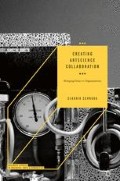Abstract
Artists and scientists like to refer to artscience collaboration to a space for exploration and experiments that is not bound to other organizational restrictions or where they can talk freely about unique ideas. The formats of artscience collaboration often are not bound to organizational structures; these projects are neither part of routines nor are they standard projects. They break formal structures and open up spaces for learning and idea development without predefined rules, for example, like interaction structures or scientific, corporate, and artistic goals. Such spaces can be used individually for personal development, exploration, creation of experimental work, playful testing of new ideas, and much more, without being bound to former rules, hierarchies, or evaluation by peers. In anthropology these states have first been named as “liminal”, spaces on a threshold and in-between (Van Gennep 1909; Turner 1966). Such space is not always constructed and signified by physical room, but by social practice. Liminal spaces are rather cognitive and experiential phases to break out from the “normal” spaces of routine life.
Access this chapter
Tax calculation will be finalised at checkout
Purchases are for personal use only
Notes
- 1.
Cultural change in organizations (see Howard-Grenville et al. 2011), influence of project-based and temporary work on workers (see Czarniawska and Mazza 2003; Eriksson-Zetterquist 2002; Johnsen and Sørensen 2014; Garsten 1999), in times of crisis (Powley 2009), and how to create liminal spaces for effective strategic workshops (Johnsen et al. 2010).
- 2.
In this project I acted as a project manager and facilitated and mentored the residencies at Ars Electronica Futurelab.
- 3.
- 4.
References
Berthoin Antal, A., & Strauß, A. (2016). Multistakeholder Perspectives on Searching for Evidence of Values-Added in Artistic Interventions in Organizations. In U. Skoldberg, J. Woodilla, & A. Berthoin Antal (Eds.), Artistic Interventions in Organizations: Research, Theory and Practice (pp. 37–59). London/New York: Routledge.
Czarniawska, B., & Mazza, C. (2003). Consulting as a Liminal Space. Human Relations, 56(3), 267–290.
Eriksson-Zetterquist, U. (2002). Gender Construction in Corporations. In B. Czarniawska & H. Hopfl (Eds.), Casting the Other: Production and Maintenance of Inequality in Organizations (pp. 89–103). London: Routledge.
Garsten, C. (1999). Betwixt and Between: Temporary Employees as Liminal Subjects in Flexible Organizations. Organization Studies, 20(4), 601–617.
Howard-Grenville, J., Golden-Biddle, K., Irwin, J., & Mao, J. (2011). Liminality as Cultural Process for Cultural Change. Organization Science, 22(2), 522–539.
Johnsen, C. G., & Sørensen, B. M. (2014). ‘It’s Capitalism on Coke!’: From Temporary to Permanent Liminality in Organization Studies. Culture and Organization, 21(4), 321–337.
Johnsen, C. G., Prashantham, S., Floyd, S. W., & Bourque, N. (2010). The Ritualization of Strategy Workshops. Organization Studies, 31(12), 1589–1618.
Kabo, J., & Baillie, C. (2010). Engineering and Social Justice: Negotiating the Spectrum of Liminality. In R. Land, J. H. F. Meyer, & C. Baillie (Eds.), Threshold Concepts and Transformational Learning (pp. 303–315). Rotterdam: Sense Publishers.
Lefebvre, H. (1991). The Production of Space. Oxford: Blackwell Publishing.
Macho, T. (2004). Das zeremonielle Tier. Rituale – Feste – Zeiten zwischen den Zeiten [The Ceremonial Animal: Rituals – Feasts – Times Between Times] St. Stefan: Styria.
Murray-Leslie, A. (2018). Artistic Methods with Computer Enhanced Footwear: Through Iterative Design Processes and Audiovisual Theatrical Performance. PhD Thesis, University of Technology, Sydney.
Powley, E. H. (2009). Reclaiming Resilience and Safety: Resilience Activation in the Critical Period of Crisis. Human Relations, 62(9), 1289–1326.
Savin-Baden, M. (2016). The Impact of Transdisciplinary Threshold Concepts on Student Engagement in Problem-Based Learning: A Conceptual Synthesis. Interdisciplinary Journal of Problem-Based Learning, 10(2), 3.
Schnugg, C. A. (2011). Setting the Stage for Something New. Proceedings of the 6th International Conference on the Arts in Society, Berlin.
Sutton-Smith, B. (1972, December 1). Games of Order and Disorder. Paper Presented to Symposium on “Forms of Symbolic Inversion.” American Anthropological Association, Toronto.
Swan, J., Scarbrough, H., & Ziebro, M. (2016). Liminal Roles as a Source of Creative Agency in Management: The Case of Knowledge-Sharing Communities. Human Relations, 69(3), 781–811.
Turner, V. (1966). The Ritual Process: Structure and Anti-structure. Ithaca: Cornell University Press.
Turner, V. (1974). Liminal to Liminoid, in Play, Flow, and Ritual: An Essay in Comparative Symbology. The Rice University Studies, 60(3), 53–92.
Turner, V. (1982). From Ritual to Theatre: The Human Seriousness at Play. New York: Performing Arts Journal.
Turner, V. (1987). The Anthropology of Performance. New York: Performance Arts Journal Publications.
Van Gennep, A. (1909). Les rites de passage [Rites of Passage, 1960]. London: Routledge and Kegan Paul.
Wall, P., & Englert, J. (2016). Business Ethnography: Including Liminality in Pursuit of Innovation. Journal of Business Anthropology, 2(2016), 58–76.
Author information
Authors and Affiliations
Corresponding author
Rights and permissions
Copyright information
© 2019 The Author(s)
About this chapter
Cite this chapter
Schnugg, C. (2019). Spaces In-Between: Liminality. In: Creating ArtScience Collaboration. Palgrave Studies in Business, Arts and Humanities. Palgrave Macmillan, Cham. https://doi.org/10.1007/978-3-030-04549-4_4
Download citation
DOI: https://doi.org/10.1007/978-3-030-04549-4_4
Published:
Publisher Name: Palgrave Macmillan, Cham
Print ISBN: 978-3-030-04548-7
Online ISBN: 978-3-030-04549-4
eBook Packages: Business and ManagementBusiness and Management (R0)

